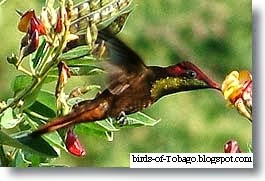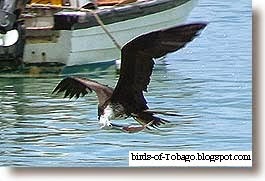 |
| Ruby-topaz Hummingbird (Chrysolampis mosquitus) |
Order : Apodiformes
The Apodiformes are made up of two distinct groups of aerial masters, the Swifts (Apodi) and Hummingbirds (Trochili). The Swifts being split into two families True Swifts (Apodidae) and Tree Swifts (Hemiprocnidae), The Hummingbirds are one family (Trochilidae). The feet in true Swifts are weak and they are unable to perch on wires or branches but cling to a vertical surface except when nesting. Swifts drink by swooping down at the surface of a body of water and take nesting materials and prey in full flight. Most courtship rituals take place on the wing and copulation is known to take place in full flight. Tree Swifts and Hummingbirds can perch, and some species can be highly territorial and will attack vastly larger birds such as Hawks, and even mammals such as Humans.
Family : Hummingbirds (Trochilidae)
Hummingbirds are only found in the Americas ranging from southern Canada and Alaska to Tierre del Fuego, including the West Indies. Some northern American species migrate thousands of kilometers south, an amazing feat for such small birds, and certain species are increasingly migrating to eastern North America due to the hanging of artificial feeders in gardens, surviving in temperatures as low as -20%C. They are capable of hovering in mid air and they are the only bird that can fly backwards. All are nectar eaters being attracted to brightly coloured flowers, mainly red, and most take insects. Some species have developed special bills adapted to specific flowers. Unlike other birds the Hummingbirds wings connect at the shoulder and they can achieve between 15 and 80 beats per second depending on the size of the bird, the larger the bird, the slower the beat. The Bee Hummingbird of Cuba and the Isle of Pines is the smallest living bird, measuring around 5.5 cm and weighing 2g.
Name : Ruby-topaz Hummingbird (Chrysolampis mosquitus)
Length : 8 - 9 cm ( 3 - 3½ in )
A Hummingbird of open countryside, garden and cultivated areas, the Ruby-Topaz ranges from the Lesser Antilles and tropical northern South America south to Brazil. The male has green glossed dark brown upperparts the crown and nape are glossy red and the throat and breast are a brilliant gold, though these colours only show at specific angles. The tail is chestnut tipped with black. Females and immature irds are brownish above with grey below and a short black strip from chin to breast. The bill is short and straight. This species can be seen taking nectar from trees and bushes and flowers, or hunting for insects at the forest edge. The female lays two eggs in a tiny cup nest in the fork of a low branch.
#Ruby-topaz Hummingbird #Chrysolampis mosquitus #Hummingbirds #Trochilidae #Apodiformes #birds of the West Indies #Birds of Tobago #birds
Bird identification photos

































